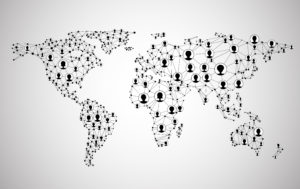I was listening to an interview on the business channel the other day with the CEO of Starwood Hotels. I thought I heard him say that in the last twenty years three billion people worldwide have gone from poverty to be participants in the consumer class. That’s incredible, I thought, inasmuch as there are only six billion people living on the planet today.
As if he heard my thought he followed up by saying that in less than twenty years the possibility exists that the other three billion will also enter into the consumer class. If that is true the greatest social revolution in history will have taken place in less than forty years.
But he was not done with his observations. He added that the youth of the world now have more in common with each other than they do with the “next generation up” in their own culture. His reasoning was that because consumer brands are global, and because today’s youth are so brand savvy, relationships have been established globally using consumer goods as the medium. My opinion? Let’s hear it for Nike, Apple and McDonalds – private capital uniting people in a safe, non-ideological way.
A worldwide consumer class, whose standard of living will be improving over the next decades, has some important things going for it. For one, they will probably choose not to go to war with one another. And, they definitely will not tolerate acts of terror on people living in other countries. After all, these are their new friends that they now share things in common with. Quite simply, if these trends hold, we may be witnessing the birth of a generation of peace. Journalist Thomas Friedman calls this phenonmon a “Flat World”, suggesting a world that is becoming more equal and connected.
For those of us in business this trend has important implications for our success. As one who owns a business, I have noticed that it’s getting easier to do business internationally. Anymore, it’s virtually impossible to keep enterprising entrepreneurs away from global consumers. One way or another, today’s business people connect with people of different lands, cultures, and ideologies. I attribute this almost exclusively to one cause: the creation of a global system of information exchange. People find people with common interests by means of going where the new “information network” leads them.
Today’s global information network has the chief characteristic of moving sideways or horizontally. In other words information is best used when it is moving freely across barriers. When allowed to “swirl” around the earth at almost the speed of light, information creates value on its own. It does this by automatically connecting with other information also moving freely. How it connects is the entrepreneur’s opportunity.
For example, when I became weary of working in a vertical structure, where the only information I exchanged was up to my boss, I decided to go rogue. I stepped to the side of my up and down track, and started sharing information horizontally, or with people who were not part of my world. I told everybody and anybody who would listen that I wanted to do something different with my life.
One day my message connected. A radio executive (of all people) asked me if I could help him improve his relationship with one of his key employees. I agreed and the rest is history. That was the start of my career as a management consultant, radio commentator, and writer. Twenty-five years later I’m still doing the same kind of sideways communicating, only know I also embrace the internet, voicemail, email, blogging, social network sites and text messaging. No matter what I send out over the network, I always (yes, always) get back more than I send out. I then spend time culling through this information until I see an opportunity emerge. It’s usually in the form of a need that someone has that I think I can meet. The rest, once again, is history.
The world is growing sideways. That’s how new wealth creation is taking place globally. The vertical up and down world is being vacated. With each random click of your digital device, the orderly up and down world grows smaller and poorer, while the sideways world grows larger and richer.
